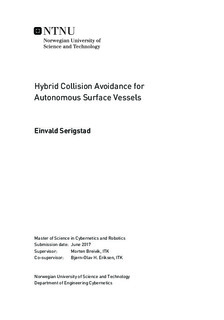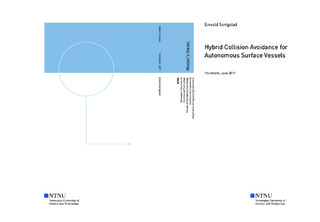| dc.description.abstract | When developing autonomous vehicles, collision avoidance (COLAV) methods are essential. COLAV methods are generally divided into two groups; reactive and deliberate methods. Reactive COLAV methods act solely on sensor data from the immediate environment, while deliberate methods generate global paths based on available data of the complete environment. The focus of this thesis is mainly on a reactive COLAV method named Dynamic Window (DW) algorithm. The DW algorithm has previously been modified to consider vehicles with second order nonholonomic constraints, such as autonomous surface vehicles (ASVs). This modification is denoted Algorithm A and is further developed in this thesis. Algorithm A introduces an avoidance region around obstacles, which the vehicle is motivated to avoid. If the vehicle is inside the avoidance region, however, Algorithm A will not be motivated to leave the region and will lose the ability to evaluate the vehicle distance towards obstacles. Furthermore, the region may cause problems when travelling through narrow passages.
Two new DW algorithms, Algorithm B and Algorithm C, are introduced in this thesis to cope with the avoidance region issues. While Algorithm A focuses purely on reaching the goal without entering the avoidance region, Algorithm B will also try to exit the region if entered. Algorithm C is less hesitant to enter the avoidance region but prefers trajectories that has a minimum portion inside the avoidance region.
To avoid being trapped in a local minima and enable the use of predefined trajectories, a hybrid COLAV method consisting of a reactive and a deliberate method is introduced. The DW algorithm is modified to suit the hybrid method, resulting in the Hybrid Dynamic Window (HDW) algorithm. The algorithm works both as a reactive COLAV method, and an interface between the reactive and deliberate method. The Rapidly-Exploring Random Tree (RRT) algorithm, which is a deliberate method, generates a planned trajectory towards the goal for the HDW algorithm to track. The HDW algorithm tracks the planned trajectory by inputting a desired ASV trajectory that aligns as good as possible with the planned trajectory.
A simulation environment and an ASV model are implemented to assess the new algorithms based on several performance metrics. The algorithms are tested in various scenarios designed to challenge potential weaknesses of the algorithms. A new performance metric, integral of distance inside avoidance region (IDI), is introduced to measure the algorithm performance.
The introduction of Algorithm C greatly improves the performance when operating close to or inside the avoidance region. Furthermore, applying the modifications introduced in Algorithm C to the HDW algorithm guided by the RRT algorithm, results in a consistently good ASV behaviour, where the ASV always keeps a safe distance to obstacles. | |

